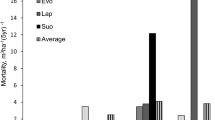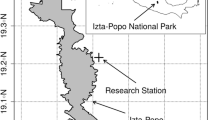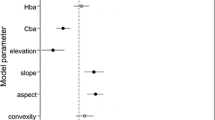Abstract
Data on individual tree mortality in relatively healthy (Berezinskiy biosphere reserve) and damaged (surroundings of the mineral fertilizer plant ‘Achema’) even-aged Scots pine (Pinus sylvestris L.) stands are presented. Tree size and competition intensity were found to be the most significant predictors of individual tree mortality in all age groups of the relatively healthy Scots pine stands, however, an essential reduction in the closeness of relations between the tree mortality rate and these variables was determined with the aging of stands. An exponential decrease in tree mortality probability with an increase of tree size is characteristic for trees suffering different competition intensity, however, this decrease becomes much more pronounced as the competition pressure increases. The relations of different tree and stand variables with tree mortality probability have been found to become much weaker in the polluted environment. An exponential increase in tree mortality probability with an increase of crown defoliation was characteristic of damaged Scots pine stands, however, the rate of the increase was different in different age and diameter classes. The impact of crown defoliation on tree mortality rate increased with the aging of stands. At the same defoliation level, individual tree mortality probability was much higher for smaller suppressed trees, however, a relative increase in tree mortality probability along with an increase of crown defoliation was more pronounced for dominant trees. Conclusion: a higher mortality of damaged (defoliated) trees should be considered while assessing losses in forest productivity in a polluted environment.
Similar content being viewed by others
References
Armolaitis, K.: 1998, (Nitrogen pollution on the local scale in Lithuania: Vitality of forest ecosystems), Environ. Pollut. 102, 55–60.
Barclay, H. J. and Layton, C. R.: 1990, (Growth and mortality in managed Douglas fir: Relation to a competition index), For. Ecol. Manage. 36, 187–204.
Bigler, Ch. and Bugmann, H.: 2003, (Growth-dependent tree mortality models based on tree rings), Can. J. For.Res. 33, 210–221.
Buchman, R. G., Pedersen, S. P. and Walters, N. R.: 1983, (A tree survival model with application to species of theGreat Lakes region), Can. J. For. Res. 13, 601–608.
Burgman, M., Incoll, W., Ades, P., Ferguson, I., Fletcher, T. and Wholers, A.: 1994, (Mortality models for mountainand alpine ash), For. Ecol. Manage. 67, 319–327.
Cannell, M. G. R., Rothery, P. and Ford, E. D.: 1984, (Competition within stands of Picea sitchensis and Pinus contorta), Ann. Bot. 53, 349–362.
Crow, G. R. and Hicks, Jr., R. R.: 1990, (Predicting mortality in mixed oak stands following spring insectsdefoliation), For. Sci. 36, 831–841.
Dahms, W. G.: 1983, (Growth simulation model for lodgepole pine in central Oregon), Research Paper, PNW–302, USDA Forest Service, pp. 22.
Daniels, R. F.: 1976, (Simple competition indices and their correlation with annual loblolly pine tree growth), For. Sci. 22, 454–456.
Dobbertin, M. and Brang, P.: 2001, (Crown defoliation improves tree mortality models), For. Ecol. Manage. 141, 271–284.
Eid, T. and Tuhus, E.: 2001, (Models for individual tree mortality in Norway), For. Ecol. Manage. 154, 69–84.
Franklin, J. F., Shugart, H. H. and Harmon, M. E.: 1997, (Tree death as an ecological process), BioScience 37, 550–556.
Gottschalk, K. W., Colbert, J. J. and Feicht, D. L.: 1998, (Tree mortality risk of oak due to gypsy moth), Eur. J.For. Path. 28, 121–132.
Hamilton, D. A.: 1974, (Event probabilities estimated by regression), General Technical Report, INT-152, USDA Forest Service, pp. 18.
Hamilton, D. A.: 1986, (A logistic model of mortality in thinned and unthinned mixed conifer stands of northernIdaho), For. Sci. 32, 989–1000.
Hill, G.: 1993, (Untersuchungen über den Einfluss des Witterungsverlaufes auf Absterbevorgänge in älterenKiefernbeständen (Pinus sylvestris L.)), Forstarchiv 64, 3–9 (in German).
Hosmer, D. W. and Lemeshow, S.: 1989, Applied Logistic Regression, John Wiley and Sons, NewYork, pp. 307.
Juknys, R.: 1990, (Growth and productivity of even-aged Scots pine stands in the polluted environment), Thesis of Habilitation Work, Sukachov Institute of Forest and Wood, Krasnoyarsk, Russia, pp. 40(in Russian).
Juknys, R., Vencloviene, J. and Stravinskiene, V.: 2002, (Tree-ring analysis for the assessment of anthropogenicchanges and trends), Environ. Monit. Assess. 77, 81–97.
Juknys, R., Vencloviene, J. and Stravinskiene, V.: 2003, (Scots pine growth and condition in a pollutedenvironment: From decline to recovery), Environ. Pollut. 125, 205–212.
Kramer, H.: 1986, (Relation between crown parameters and volume increment of Picea abies stands damaged byenvironmental pollution), Scan. J. For. Res. 1, 251–263.
Lorimer, C. G.: 1983, (Test of age-independent competition indices for individual trees in natural hardwood stands), For. Ecol. Manage. 6, 343–360.
Lynch, T. B., Huebschmann, M.M. and Murphy, P.A.: 1998, (A survival model for individual shortleaf pine trees ineven-aged natural stands), in M. Hansen and T. Burk (eds), ( Integrated Tools for Natural ResourcesInventories in the 21st Century), An International Conference on the Inventory and Monitoring of ForestedEcosystems, Boise, North Central Research Station, USDA Forest Service, pp. 533–538.
Monserud, R. A.: 1976, (Simulation of forest tree mortality), For. Sci. 22, 438–444.
Monserud, R. A. and Sterba, H.: 1999, (Modeling individual tree mortality for Austrian forest species), For.Ecol. Manage. 113, 109–123.
Munro, D. D.: 1974, (Forest growth models – a prognosis), in Proceedings of the Congress IUFRO S4-01-4 (Growth Models for Tree and Stand Simulation), Royal College of Forestry, Stockholm, Sweden, pp. 7–21.
Nagelkerke, N. J. D.: 1991, (A note on a general definition of the coefficient of determination), Biometrika. 78, 691–692.
Ozolincius, R., Miksys, V. and Stakenas, V.: 2004, (Tree damage and mortality in Lithuanian forests), Transactions of the Faculty of Forestry, Estonian Agricultural University 37, 75–79.
Palahia, M., Pukkalab, T., Miinac, J. and Monterod, G.: 2003, (Individual-tree growth and mortality models for Scotspine in north-east Spain), Ann. For. Sci. 60, 1–10.
Pedersen, B. S.: 1998, (Modeling tree mortality in response to short- and long-term environmental stresses), Ecol. Model. 105, 347–351.
Petras, R., Nociar, V. and Pajtik, J.: 1993, (Changes in increment of spruce damaged by air pollution), Lesnictvi-Forestry 39, 116–122.
Soderberg, U.: 1991, (The relation between increment and defoliation on spruce-fir stand development in Sweden), in: IUFRO Workshop on Monitoring Air Pollution Impact on Permanent Sample Plots (Data Processing and ResultInterpretation), Prachatice, CSFR, 2-6 September, pp. 119–127.
Solomon, D. S., Zhang, L. B., Thomas, B. and Larrick, D. S.: 2003, (Mortality patterns following spruce budworminfestation in unprotected spruce-fir forests in Maine), North. J. Appl. For. 20, 148–153.
Sutherland, E. K. and Martin, B.: 1990, (Growth response of Pseudotsuga menziesii to air pollution from coppersmelting), Can. J. For. Res. 20, 1020–1030.
Steinman, J. R. and MacLean, D. A.: 1994, (Predicting effects of defoliation on spruce-fir stand development: Amanagement-orientated growth and yield model), For. Ecol. Manage. 69, 283–298.
Walker, S. H. and Dunkan, D. B.: 1967, (Estimation of the probability of an event as a function of several independentvariables), Biometrika 54, 167–179.
Wykoff, W. R., Crookston, N. L. and Stage, A. R.: 1982, (User's guide to the Stand Prognosis Model). GeneralTechnical Report, INT-133, USDA Forest Service, pp. 112.
UN/ECE, 1994, (Manual on methods and criteria for harmonized sampling, assessment, monitoring and analysis of theeffects of air pollution on forests), Geneva, pp. 172.
Yang, Y., Titus, S. J. and Huang, S.: 2003, (Modeling individual tree mortality for white spruce in Alberta), Ecol. Model. 163, 209–222.
Yao, X., Titus, S. J. and MacDonald, S. E.: 2001, (A generalized logistic model of individual tree mortality for aspen, white spruce and lodgepole pine in Alberta mixedwood forests), Can. J. For. Res. 31, 283–291.
Author information
Authors and Affiliations
Corresponding author
Rights and permissions
About this article
Cite this article
Juknys, R., Vencloviene, J., Jurkonis, N. et al. Relation Between Individual Tree Mortality and Tree Characteristics in a Polluted and Non-Polluted Environmentx. Environ Monit Assess 121, 519–542 (2006). https://doi.org/10.1007/s10661-005-9152-y
Received:
Accepted:
Published:
Issue Date:
DOI: https://doi.org/10.1007/s10661-005-9152-y




